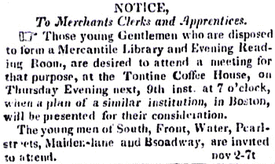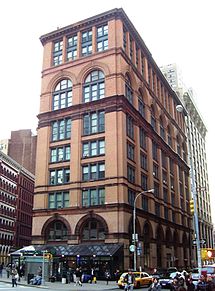- Center for Fiction
-
 The Mercantile Library in the Astor Opera House building, 1886
The Mercantile Library in the Astor Opera House building, 1886
- New York Mercantile Library redirects here
The Center for Fiction is a not-for-profit organization in New York City at 17 East 47th Street, between Madison and Fifth Avenues in Midtown Manhattan, which works to promote fiction and literature and to give support to writers. It was founded in 1820 as the (New York) Mercantile Library.
The Center, which is one of 17 remaining membership libraries in the United States, three of which are in New York City,[1] maintains a large circulating library of 20th and 21st century fiction, in addition to many stored volumes of 19th century fiction. It also stocks non-fiction volumes on subjects related to literature.[2] It maintains a Reading Room, rents space to writers at low-cost and presents literary programs to the public.[3]
Contents
History
The foundation of the Mercantile Library Association was instigated by the New York Chamber of Commerce,[4] which placed newspaper advertisements in November 1820 asking merchant clerks to meet at a local coffee house to discuss forming an organization based on the Mercantile Library in Boston, which had been created earlier that year.[3] The purpose of the new organization was to provide the city's growing population of clerks with an alternative to what were considered to be immoral entertainments and other vices of the city.[4][5]
The Association's first subscription circulating library, which had 700 volumes[6] in rented rooms at 49 Fulton Street in Manhattan, was open to most of the general public, but only merchant clerks were allowed to vote for and be officers in the Association.[7] In 1830, the library moved to a new building, called "Clinton Hall", at Nassau and Beekman Streets, which the Clinton Hall Association, made up of prominent members of the Mercantile Library Association, has raised funds to construct.[7] Frequent lectures were presented by the library,[8] including by Ralph Waldo Emerson [9] and Oliver Wendell Holmes.[10]
By 1853, the Association had over 4,000 members[11] and over 30,000 volumes, and in 1854, the library moved again, this time uptown to the Astor Opera House building on Lafayette Street between Astor Place and East 8th Street.[7] The opera house had closed its doors as a result of the Astor Place riot of 1849, and the building was sold for $140,000[12] to the Association, which renamed it "Clinton Hall" and moved the library there as a place which was more convenient to its members.[7] At its new location, the Association offered classes and public lectures, including by Frederick Douglass, William Thackeray, and Mark Twain,[3] and functioned as a cultural center.[7] Membership during this period reached at least 12,000, while the library itself amassed 120,000 volumes, making it the largest circulating library in the United States at the time.[7] However, because the library did not stay open late at night, its services were not generally available to the working class, a deficit which was remedied when the Cooper Union opened a block east on Astor Place: its reading room was open until 10 p.m.[13]
11-story Clinton Hall building replaced the Opera House as headquarters. In later years it was the Chinese consulate,[14] a union headquarters, the Astor Place Hotel, an office building, and, currently, condominiums.The Center for Fiction's current headquarters at 17 East 47th StreetIn 1891, requiring more space, the Association tore down the opera house and replaced it with an 11-story building designed by George E. Harney,[15] which it also named "Clinton Hall". The new building featured a reading room on the top floor that was two-stories high,[6] and was to remain the headquarters for its library operations, which included 7 branches, until 1920, when it relocated to rented space.[6] However, in 1932, the library once again had its own building, at 17 East 47th Street, designed by Henry Otis Chapman.[6][16] Here, the Association maintained its 230,000 volumes to serve 3,000 subscribers.[7][6] The library at this time still had branches at 149 Broadway at Liberty Street and 598 Madison Avenue at 57th Street.[6]
Membership in the library declined through the following decades, and the library sold off parts of its collection in the 1970s. It also attempted a merger with Pace College, but this did not occur. By 1987 the library was in financial distress, and closed for the summer of 1987, and then indefinitely in 1989, at a time when its membership was only 375 people. The Association subsequently reorganized and reopened, with a new focus on fiction and literature.
In 1998, the ground floor of the building was renovated by Beyer Blinder Belle.[6] Because it could not afford the cost of restoring the rest of its building, the library – colloquially known as "The Merc" – had planned to sell it and more elsewhere in 2008,[17] and had been reported to have chosen a new location,[18] but as of November 2010[update] it remains at the same site.
See also
- Mercantile Library (disambiguation)
- Mercantile Library Association (Boston, Massachusetts)
- New York Public Library
- Astor Library Building
References
- Bibliography
- Burrows, Edwin G. & Wallace, Mike (1999). Gotham: A History of New York City to 1898. New York: Oxford University Press. ISBN 0195116348.
- Pascu, Elaine Weber. "Mercantile Library Association" in Jackson, Kenneth T., ed (1995). The Encyclopedia of New York City. New Haven: Yale University Press. ISBN 0300055366., p.750-751
- Notes
- ^ Eisenberg, Anne. "Libraries of Gracious Reading, for Members Only" New York Times (June 11, 2006)
- ^ "Collection" at the Center for Fiction website. Accessed: November 1, 2010
- ^ a b c "Mission & History" at the Center for Fiction website Accessed: November 1, 2010
- ^ a b Burrows & Wallace, p. 498
- ^ For additional context, see: List of libraries in 19th-century New York City
- ^ a b c d e f g Gray, Christopher. "Streetscapes/17 East 47th Street; The Mercantile Library Finds a New Literary Life" New York Times (May 6, 2001)
- ^ a b c d e f g Pascu
- ^ Archive listng at the New York Times website
- ^ "Mercantile Library Lectures" New York Times (February 17, 1852)
- ^ "Oliver Wendell Holmes commences..." New York Times (October 28, 1853)
- ^ Burrows & Wallace, p.733
- ^ "The Mercantile Library" New York Times (June 1, 1854)
- ^ Burrows & Wallace, p.782
- ^ Brozan, Nadine "Postings: On a Triangular Site at 21 Astor Place; 50 Ultramodern Condominiums Behind an Exterior From 1890" New York Times (April 6, 2003)
- ^ White, Norval & Willensky, Elliot (2000). AIA Guide to New York City (4th ed.). New York: Three Rivers Press. ISBN 0812931076.
- ^ "Our Building" at the Center for Fiction website Accessed: November 1, 2010
- ^ Koppel, Lily "Mercantile Library Moves, and Gets a Nudge Into the 21st Century" New York Times (June 3, 2008)
- ^ Konigsberg, Eric. "Historic Merc Library Will Move: Fiction, or Fact" New York Times City Room blog (May 23, 2008)
External links
Categories:- Libraries in Manhattan
- Non-profit organizations based in New York
- Proprietary libraries
Wikimedia Foundation. 2010.



